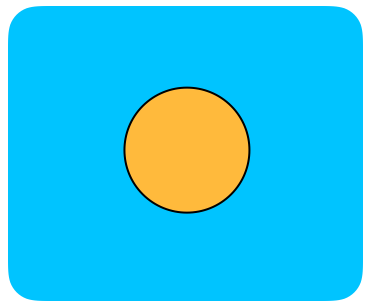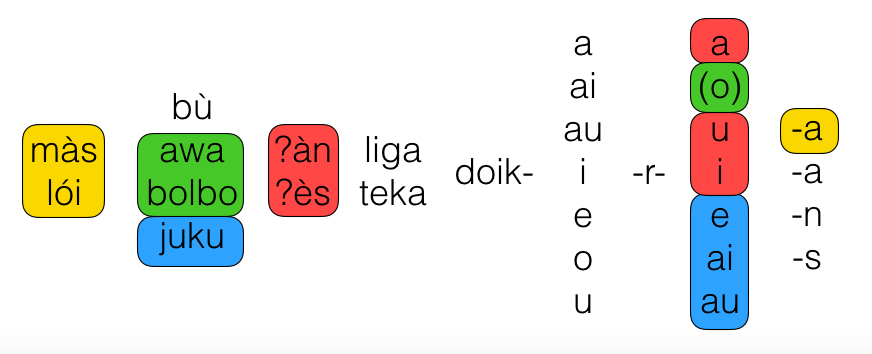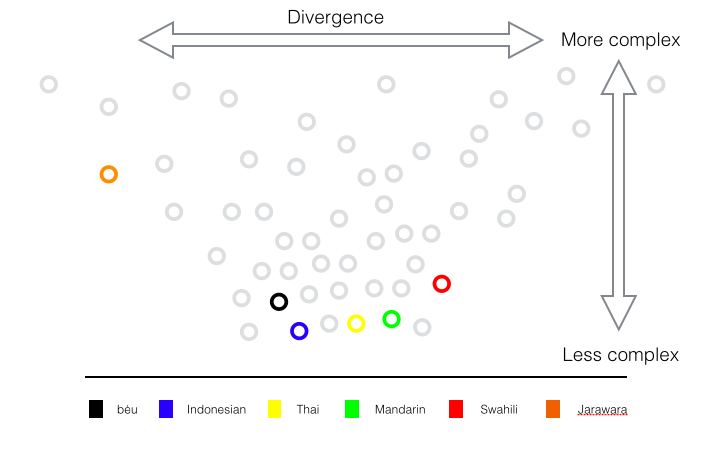Introduction to Béu: Difference between revisions
No edit summary |
No edit summary |
||
| Line 16: | Line 16: | ||
.. | .. | ||
My primary motivation in construction ‘’’béu’’’ was to make a language that would aesthetically please me. Now the natural languages which I like tend to be simple … simple phonology, simple phonotactics and simple grammar. For example Swahili, Thai, Indonesian or Chinese. Now these four languages are not a million miles away from each other in terms of structure. They all have nouns, verbs and adjectives. They all sample reality with the same pixel size (actually I believe all natural languages are similar with respect to this parameter … the only outliers that I know to exist are the conlangs “Ithkuil” and “Toki Pona”, maybe the natlang “Tok Pisin”). And they are all pretty isolating (the Swahili verb can incorporate a few elements … but there are no irregularities). It has been suggested that the reason that these languages (at least some of them) are so simple is that they were at one time a creole. What | My primary motivation in construction ‘’’béu’’’ was to make a language that would aesthetically please me. Now the natural languages which I like tend to be simple … simple phonology, simple phonotactics and simple grammar. For example Swahili, Thai, Indonesian or Chinese. Now these four languages are not a million miles away from each other in terms of structure. They all have nouns, verbs and adjectives. They all sample reality with the same pixel size (actually I believe all natural languages are similar with respect to this parameter … the only outliers that I know to exist are the conlangs “Ithkuil” and “Toki Pona”, maybe the natlang “Tok Pisin”). And they are all pretty isolating (the Swahili verb can incorporate a few elements … but there are no irregularities). It has been suggested that the reason that these languages (at least some of them) are so simple is that they were at one time a creole. What developes into a creole is what is called a "contact language" … just a list of words taken from two or three languages. However very soon certain words are grammaticized to give some tense aspect information to the verb. Then other rules solidify and other bit of grammaticization occur. The result is a creole. All creoles are very simple languages. | ||
I was aiming for the simplicity of a creole. However I believed that I could make a more “efficient” tense/aspect/evidential system than a creole. Instead of diverse elements incorporated into the Verb Phrase chaotically, I … as creator could design a compact, comprehensive paradigm from the get-go. | I was aiming for the simplicity of a creole. However I believed that I could make a more “efficient” tense/aspect/evidential system than a creole. Instead of diverse elements incorporated into the Verb Phrase chaotically, I … as creator could design a compact, comprehensive paradigm from the get-go. | ||
.. | |||
Tense/aspect/evidential paradigm shown below … | Tense/aspect/evidential paradigm shown below … | ||
| Line 25: | Line 27: | ||
For more information on the above go to section 2 in chapter 3. | For more information on the above go to section 2 in chapter 3. | ||
.. | |||
Apart from the above mentioned tones and tense/aspect/evidentials, there is not much worth mentioning about ‘’’béu’’’ … the case system is really not much more than a short-hand convention. | Apart from the above mentioned tones and tense/aspect/evidentials, there is not much worth mentioning about ‘’’béu’’’ … the case system is really not much more than a short-hand convention. | ||
| Line 64: | Line 68: | ||
.. | .. | ||
The origin of '''angwa''' are lost in the mists of time. Probably the ancestral '''béu''' community just felt that it felt right. And in these empirical times, the idea of '''angwa''' is still of central importance to '''béu'''. For example if somebody shows you around a park, they will point out what features are '''honda''' and which are '''aska'''. Nowadays the concepts of '''angwa''' live along side but separate from modern scientific ideas (some scientific types | |||
The "béu.symbol" is a orange disk with a sky blue background ... (the "béu.symbol" has both a simple and a complex representation) | The "béu.symbol" is a orange disk with a sky blue background ... (the "béu.symbol" has both a simple and a complex representation) | ||
Revision as of 23:28, 1 June 2016
..
One of the first things you notice about ‘’’béu’’’ is the tones … all monosyllables having either a high tone or a low tone. There were three motivations for that …
1) Inevitably multisyllable words are built up from monosyllables. The total number of possible monosyllables allowed by the phonology of ‘’’béu’’’ are nearly all assigned a meaning. I did not want any hint of these meanings surfacing in multisyllable words so it seemed that a good way to distance a word from the monosyllabic words which could comprise it, was to have all multisyllable words in neutral tone and all monosyllabic words in high or low tone.
2) A good percentage of the words languages have tones. I wanted ‘’’béu’’’ to be typical of all the world languages.
3) It doubles the number of possible monosyllabic words.
Well these were the motivations. I later made the set of “question words” correspond to the equivalent “generic noun” by means of a tone change. Also I later made the ergative pronouns differ in tone from the absolutive ones in order to distinguish them more.
..
My primary motivation in construction ‘’’béu’’’ was to make a language that would aesthetically please me. Now the natural languages which I like tend to be simple … simple phonology, simple phonotactics and simple grammar. For example Swahili, Thai, Indonesian or Chinese. Now these four languages are not a million miles away from each other in terms of structure. They all have nouns, verbs and adjectives. They all sample reality with the same pixel size (actually I believe all natural languages are similar with respect to this parameter … the only outliers that I know to exist are the conlangs “Ithkuil” and “Toki Pona”, maybe the natlang “Tok Pisin”). And they are all pretty isolating (the Swahili verb can incorporate a few elements … but there are no irregularities). It has been suggested that the reason that these languages (at least some of them) are so simple is that they were at one time a creole. What developes into a creole is what is called a "contact language" … just a list of words taken from two or three languages. However very soon certain words are grammaticized to give some tense aspect information to the verb. Then other rules solidify and other bit of grammaticization occur. The result is a creole. All creoles are very simple languages.
I was aiming for the simplicity of a creole. However I believed that I could make a more “efficient” tense/aspect/evidential system than a creole. Instead of diverse elements incorporated into the Verb Phrase chaotically, I … as creator could design a compact, comprehensive paradigm from the get-go.
..
Tense/aspect/evidential paradigm shown below …
For more information on the above go to section 2 in chapter 3.
..
Apart from the above mentioned tones and tense/aspect/evidentials, there is not much worth mentioning about ‘’’béu’’’ … the case system is really not much more than a short-hand convention.
Of course the fact that the concept of ’’’béu’’’ has expanded from a language to embrace all aspects of life IS worth mentioning. There is not much I have to say about that … it just happened.
I have a feeling that after the language of ‘’’béu’’’ is done and dusted, ‘’’béu’’’ will continue to expand in non-linguistic directions.
For example …..
béu specifies "best practices" for many many aspects of life. There are 3 levels for "things you must do" and 2 levels prohibition.
The relationship of husband and wife, parent and child, employer and employee, etc. etc are defined in quite some detail.
Technical standards such as screw shapes and sizes, etc. etc are defined in quite some detail.
The time of year and the manner of the five big festivals are clearly defined.
Even some metaphysics is defined ...
An important concept is aŋgwa. The closest translation to this is "harmony". aŋgwa is considered something to be cultivated.
When used in relation to motion it can be translated as "grace" When used in relation to design it can be translated as "elegance" When used in relation to text it can be translated as "poetry"
The adjective corresponding to aŋgwa is aŋgwai
aŋgwa is considered getting the right balance between honda "order" and aska "chaos".
honda and aska are considered two complementary rather than opposing concepts/forces ... a bit like YIN + YANG.
honda and aska are each associated with 4 further concepts.
Two of these concepts being nouns (dark blue) and two adjectives (red).
..
The origin of angwa are lost in the mists of time. Probably the ancestral béu community just felt that it felt right. And in these empirical times, the idea of angwa is still of central importance to béu. For example if somebody shows you around a park, they will point out what features are honda and which are aska. Nowadays the concepts of angwa live along side but separate from modern scientific ideas (some scientific types
The "béu.symbol" is a orange disk with a sky blue background ... (the "béu.symbol" has both a simple and a complex representation)
..
 Maybe too yellow => more red needed ??
Maybe too yellow => more red needed ??
..
The language and culture of béu are listed in the 10 chapters that follow. At the moment [2 June 2016] only the first chapter can really be considered finished.
The cultural information [chapters 7 and 8] seem to be pretty solid but the linguistic sections are still in flux. Hopefully in the not too distant future the language will become equally solid.
..
A brief history
..
The very first language that I tried to construct was called HARWENG. This was eventually given up about 14 years ago. The basic problem was that I didn't know enough about linguistics. I layed down the basic linguistic rules of HARWENG, but when I tried to build upon these basics, what I build did not seem to stick together : it did not make a consistent whole, so reluctantly I put HARWENG aside.
My second project was called SEUNA and this was also put aside after a number of years (I guess for similar reasons to why HARWENG was put aside).
béu* is my third language and I have hopes of taking this one to fruition.
*the diacritic above the "e" indicates that the word has a high tone. All words in this language I will indicate by bold type. From now on the only items in bold type will be elements and words from the language of béu.
..
Motivation
..
What interests me most in linguistics is the area where logic, grammar and semantics intersect. Also I very much appreciate the elegant patterns that are found in natural languages. I guess every natural language exhibits elegant patterns over part of their structure.
However most natural languages also have elements which I don't like. It seems that the natural tendencies that forge a language also "limit" a language in a fundamental way : I find all natural languages insufficiently "efficient" and "elegant" for my taste : evolution by "decree" rather than natural forces just seems so much better.
I have always been a perfectionist ... keenly aware of all the imperfections that everyday life entails. I have always had the feeling that in order to build perfection you must start at the very bottom ... and I also have had the feeling that language is the most basic thing* that makes us human. Hence the first step to making a better world is to develop a logical, elegant and beautiful language.
All of the above motivated me to construct a new language.
..
Influences
..
The best constructed language which I have so far come across was CEQLI. However it was not much more than a sketch. Also the two languages created by Dirk Elzinga ... TEPA and SHEMSPREG were also very neat. However again they were not fully thought out ... not complete languages. I intend that béu will be a fully formed language.
I have not mentioned any of Tolkien's languages as an influence. This is because Tolkien never published a canonical version of ANY of his many constructed languages. However I feel a great affinity for J.R.R. ... I think our world views are remarkable similar ... well at least when it comes to our "secret vice"
..
Structure
..
The "bubble fountain" above is how I see the world 4,000 languages (OK I haven't drawn 4,000 bubbles ... pretend) of the world. The vertical axis is complexity. The black line at the bottom represents zero ... the way that a group of people would communicate initially if they all spoke totally different languages and were forced to associate together by some twist of fate. There would be zero grammaticisation ... it would be a very inefficient means of communication and I would presume quite frustrating to try and converse in. The horizontal axis represents how far the different languages diverge from each other (this "divergence" should be multi-dimensional because of course languages diverge from each other in many many different ways ... but I am afraid we must make do with one dimension on my little chart).
You will notice that the simple languages at the bottom of the chart differ less from each other less than the more complex languages at the top. These simple languages tend to have one concept to one word ... they are analytic. Now a simple language is just as fit-for-purpose as a complicated language. And I certainly didn't want complexity for complexity's sake : I just wanted a language that was easy to learn and that would appear to be "natural". Hence the structure of béu is not a million miles away from the structure of English ... or Mandarin. In its final form béu seems like a natural language : the grammar and the "patterns" in the language wouldn't be considered out of place in a natural language.
..
Evolution
..
By decree but also evolved
..
In its long history (HARWENG => SEUNA => béu) it has changed many many times. It has gone thru' many iterations**. I would change one part of the grammar and then find that this change didn't fit with something else. So I would change it back, or modify the "something else", or maybe try out a completely new paradigm. This happened many many times. I suppose the changes that happened in in the development of béu are similar to the diachronic changes that happen to natural languages, and hence béu ended up looking quite naturalistic.
* I believe that language co-evolved with the increase in the human cranial capacity ... so language has been with us for well over a million years.
** A good analogy to this how a protein takes its shape. This is a long linear chain molecule that folds up on itself to takes on a very definite and complicated shape. The final shape is determined by a series of movements that are initiated by the attractive and repulsive forces that the various links in the chain have for each other. In a similar way the final shape of béu was determined by the way that different grammatical patterns and phonological patterns either clashed with each other, or matched with each other through a number of successive iteration.
..
Addendum
..
When talking about grammar I follow the lead given by R.M.W. Dixon in "Basic Linguistic Theory". I would thoroughly recommend this book. As well as giving a broad topological perspective of the World's languages, it puts the convoluted terminology that has grown up in the field of linguistics over the years, firmly in its place.
..
Index
- Introduction to Béu
- Béu : Chapter 1 : The Sounds
- Béu : Chapter 2 : The Noun
- Béu : Chapter 3 : The Verb
- Béu : Chapter 4 : Adjective
- Béu : Chapter 5 : Questions
- Béu : Chapter 6 : Derivations
- Béu : Chapter 7 : Way of Life 1
- Béu : Chapter 8 : Way of life 2
- Béu : Chapter 9 : Word Building
- Béu : Chapter 10 : Gerund Phrase
- Béu : Discarded Stuff
- A statistical explanation for the counter-factual/past-tense conflation in conditional sentences



